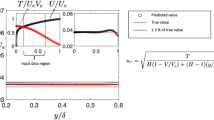Abstract
A method is developed to infer the wall shear stress for three-dimensional turbulent boundary layers based on the assumption that the resultant surface shear stress and the effective velocity based on Prahlad's model correlates the velocity profile into its two-dimensional form. Existence of the near wall region similarity has been demonstrated for three-dimensional turbulent boundary layers.
Similar content being viewed by others
Abbreviations
- A and B:
-
constants connected with log-law, Eq. (1)
- \(c_{f_1 } \) :
-
skin-friction coefficient in the main flow direction
- \(F\left( {\frac{y}{\delta }} \right)\)):
-
QSW or Coles function
- \(F_1 \left( {\frac{y}{\delta }} \right)\) :
-
QSW function
- \(F_2 \left( {\frac{y}{\delta }} \right)\) :
-
Coles function
- H :
-
shape parameter
- n :
-
exponent in power-law profile, Eq. (4)
- QSW:
-
quarter-sine wave function
- q :
-
resultant velocity
- q * :
-
resultant shear velocity
- q + :
-
non-dimensionalised velocity vector = q/q *
- U :
-
free stream velocity
- u :
-
main stream velocity component in the boundary layer
- u * :
-
shear velocity in the main stream direction
- V :
-
effective velocity
- w :
-
cross-flow component in the boundary layer
- y :
-
coordinate normal to the surface of the wall
- β :
-
angle between the velocity vector at any point with velocity vector at y=δ
- β 0 :
-
limiting wall-stream angle
- δ :
-
boundary layer thickness
- ϑ 11 :
-
momentum thickness for velocity profile in main stream direction
- ν :
-
kinematic viscosity
- η :
-
y/δ
- η + :
-
yq */ν
- p :
-
density of fluid
- τ wx :
-
wall shear stress in main stream direction
- τ wz :
-
wall shear stress in cross-flow direction
References
Swamy, N. V. C., ZFW 19 (1971) 496.
Pierce, F. J. and D. Krommenhoek, AD 680 973 Durhan (1969).
East, L. F. and R. P. Hoxey, ARC R and M 3653 (1971).
Prahlad, T. S., J. AIAA 6 (1968) 1772.
Clauser, F. H., J. Aeron. Sci. 21 (1954) 91.
Pierce, F. J. and J. Zimmermann, J. Fluids Eng. 95 (1973) 61.
White, F. M., Viscous fluid flow, McGraw Hill Book Company, 1974.
Hornung, H. G. and P. N. Joubert, J. Fluid Mech. 15 (1963) 368.
Coles, D., J. Fluid Mech. 1 (1956) 191.
Johnston, J. P., J. Basic Eng. 82 (1960) 233.
Perry, A. E. and P. N. Joubert, J. Fluid Mech. 22 (1965) 285.
White, F. M., R. C. Lessmann and G. H. Christoph, Air Force Flight Dynam. Lab., Ohio, Rep. AFFDL-TR 72–136 (1972).
Swamy, N. V. C. and P. A. Aswatha Narayana, Zeitschr. Flugw. 23 (1975) 400.
Swamy, N. V. C. and P. A. Aswatha Narayana, Zeitschr. Flugw. Weltraum. 1 (1977) 414.
Doenhoff, V. and N. Tetervin, NACA Rep. 771 (1943).
Author information
Authors and Affiliations
Rights and permissions
About this article
Cite this article
Swamy, N.V.C., Aswatha Narayana, P.A. Wall shear stress prediction in three-dimensional turbulent boundary layers. Appl. Sci. Res. 33, 471–480 (1977). https://doi.org/10.1007/BF00411826
Received:
Revised:
Issue Date:
DOI: https://doi.org/10.1007/BF00411826



